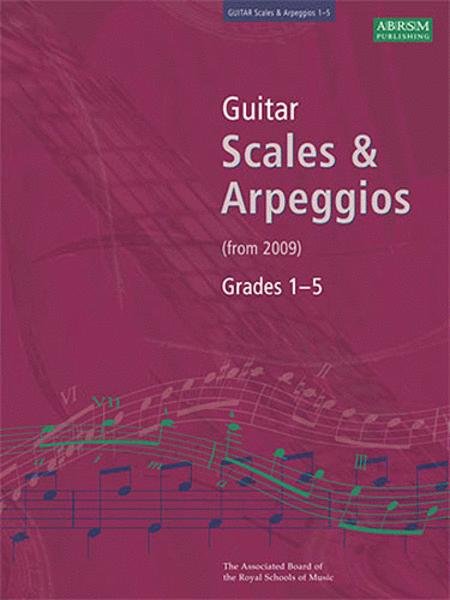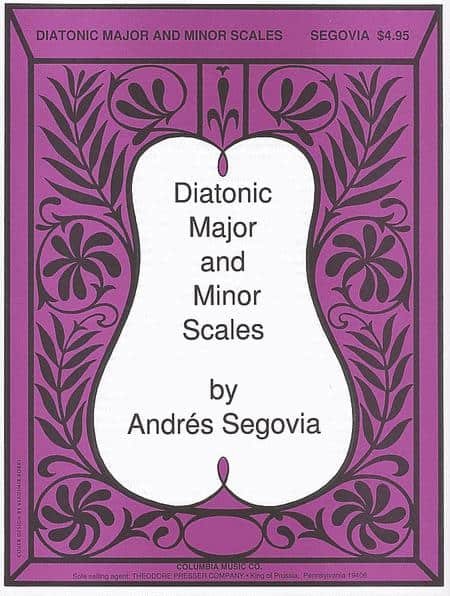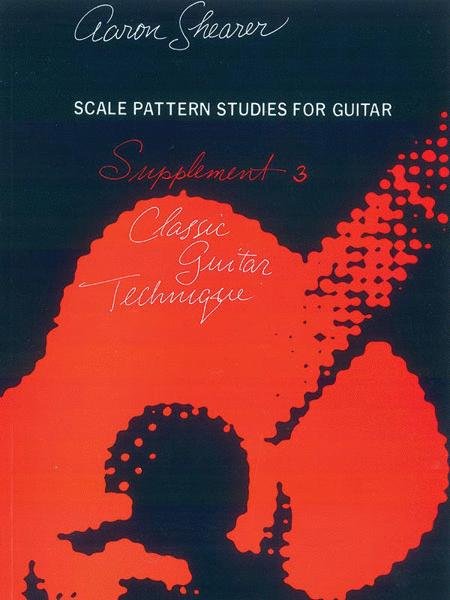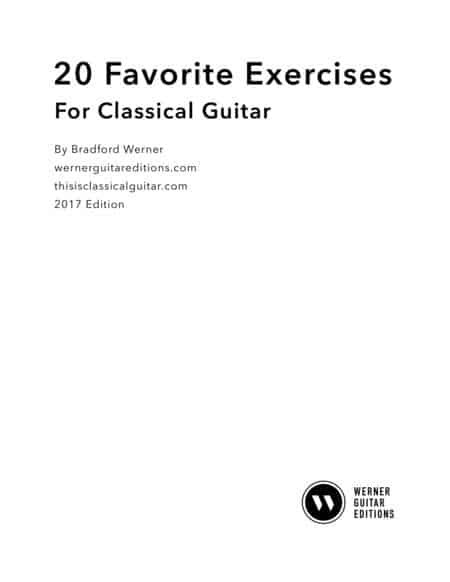Whether beginner or advanced, a classical guitar player is expected to spend a good time practicing scales. It helps beginners learn the fingerboard grid quickly and grounds them in basic music theory. It helps advanced players to master various aspects of technique even when the patterns have been long memorized.
A good book of scales not only takes the classical guitar player through the different keys and positions, it also suggests precise fingering for each scale. It builds variations and explores neighboring concepts like shifts up and down the fretboard.
- Diatonic Major and Minor Scales by Andres Segovia
- Classical Guitar Series, 2018 Edition: Technique – Royal Conservatory of Music
- Guitar Scales & Arpeggios – Associated Board of the Royal Schools of Music (ABRSM)
- Guitar & Plectrum Guitar Scales & Exercises – Trinity College of Music
- Scale Pattern Studies For Guitar, Supplement 3 by Aaron Shearer
- 20 Favorite Exercises for Classical Guitar (pdf) by Bradford Werner
Each of the publications places varying emphasis on the different aspects of playing scales. Let’s consider them in turn.
Segovia’s Scale Book: The Classic from the Master

The legendary Andres Segovia, the father of the modern classical guitar as we know it, hardly authored many books. But his famous scale book – Diatonic Major and Minor Scales – was an exception and showed the way the Master approached scales and practiced them personally.
All the keys are laid out methodically, in a matter-of-fact, take it or leave it manner for the student to figure out his or her way. You start out with the first scale C Major without worrying about sharps and flats and work your way through to the 24th one, D Minor.
Almost every concert player on the circuit today grew up cutting their teeth on Segovia’s influential scale book.
Every good tutor advises their student to use a metronome with scales and to start at a very slow tempo. The goals are the accuracy of finger placement, the accuracy of tone and accuracy of rhythm. Scales are a well recognized way to help a player at any level to achieve a continuous, connected sound (legato) as against having minute gaps between notes. Therein lies the true value of playing scales. Playing repeatedly the notes of a scale over and again with no thought given serves no purpose. Speed gain isn’t the only benefit to be derived.
Here’s performer and teacher Jason Vieaux on playing Segovia scales, something that was part of his own early days with the classical guitar.
Jason Vieaux on Segovia scales
Scale books from major exam boards: Graded for your level
The top-ranking music schools that are recognized worldwide have a formal syllabus for training music students. Bodies like Canada’s Royal Conservatory and the UK’s ABRSM (Associated Board of the Royal Schools of Music) and Trinity College have publications for classical guitar scales and exercises as part of the course curriculum.
The main advantage in using such publications, whether or not you are enrolled as a student, is that the scales are graded appropriately for different levels of playing ability. You can choose a book that matches your facility with the guitar and you also know there are other higher levels you can subsequently reach for.
ABRSM: Guitar Scales & Arpeggios

ABRSM is the oldest board among the leading ones that conducts over 600,000 music exams each year in more than 90 countries.
The guitar curriculum prescribes a couple of books for scales and arpeggios: one for the lower grades (1 to 5) and another for the higher grades (6 to 8).
Guitar Scales and Arpeggios: Grades 1-5
Guitar Scales and Arpeggios: Grades 6-8
Students are required to play all scales meant for their grade level from memory. The notes are to be played evenly, ascending and descending, and smoothly (legato). In the higher grades, the examiner may ask that the scales be played free stroke or rest stroke.
Even if you haven’t signed up for a course, this approach to the scale book is still a wise one to follow.
Trinity College Scales & Exercises
Again, the Trinity version of the scale book comes in two prescribed versions: one for grades up to 5, and another for grades 6 to 8. Check out Amazon links below:
Guitar & Plectrum Guitar Scales & Exercises Initial-Grade 5
Guitar & Plectrum Guitar Scales & Exercises Grade 6-8
As an exam prep book, this is a no-frills, no-fuss publication rather than a detailed book of instructions or guidelines. The point is if you can play the scales flawlessly, you can gauge your current playing level more or less. If you make mistakes, you know what needs to be sorted.
You can’t take a book like this too casually. It is a formal book, a serious aid to musicianship. At even Grade 3 level, the scales can be challenging. The book has material for fingerstyle guitar in a general sense including the plectrum guitar, although the classical guitar part is quite extensive and solid.
The Royal Conservatory of Music: Classical Guitar Technique
The Royal Conservatory school is hugely popular in the US and Canada for its music courses, including classical guitar. It is known for its high standard of course curriculum as well as the quality of its numerous publications for repertoire, exercises, scales and arpeggios.
The RCM Classical Guitar: Technique book is an excellent resource offering students comprehensive exercises to develop technical proficiency as they progress through their musical studies. This is more than a scale book. While it includes scale patterns with recommended fingering, it also has a variety of level-appropriate arpeggio patterns, and a technique supplement with additional exercises on slurs, tremolo, etc. It is more a basic skills primer rather than a standard scale book alone.
Scale Pattern Studies For Guitar, Supplement 3 by Aaron Shearer: Exhaustive workout
To fans of the legendary Aaron Shearer – there are thousands of them who just adore his methods on guitar learning and technique – his book Scale Pattern Studies for Guitar is THE Bible of scale studies.
It is a whopping piece of work at 280 pages, not your normal, slim scales book of 30 pages or less. As can be imagined in a book of this size, scales are dealt with in a comprehensive and thorough manner. Each scale is presented in its basic form and followed by a series of exercises based on the scale. The book is suitable for any level of player from beginner to advanced.
Shearer, for instance, reveals four mechanisms for shifting between scales as against, say, Segovia’s one shift point in a 2-octave scale – squeeze shift, glide shift, extension, and free finger shift.
The connection between sight-reading and scales is an important one. This book goes through every key and after each scale gives a few pages of melodic sight-reading to try the scale out in context. You can use this book a few minutes every day and it will keep you occupied for months. Or you could study it with a teacher. This book is a huge resource on the subject of scales.
20 Favorite Exercises for Classical Guitar by Bradford Werner: Easy download + help video
This is a quick and easy pdf download by the prolific and skilled teacher, Bradford Werner of ThisIsClassicalGuitar.com. It covers the basics any beginner wishes to learn about scales, but more than that, it has an accompanying video (see below) that tells you how best to use the pdf at the level that you are.
As noted, the idea behind playing scales while investing practice time in them is not to play them by rote and then move on to something else. Rather, scales can be used to gain control over dynamics (soft vs loud) and articulation (staccato vs legato) among other things.
20 Favorite Exercises for Classical Guitar by Bradford Werner (27 pages, pdf download)
In the video below, Werner talks about not running through scales from beginning to end mindlessly but to split the notes up so that you are constantly arriving at various ‘destination points’ as he calls them. Check the video out. He also talks about varying the rhythm with dotted notes and other good stuff.
Bradford Werner on how to play scales
What exactly is the CAGED system of scales?
In recent years, the CAGED system of learning the fretboard has become popular especially among the crossover folk from the electric/jazz guitar world. Of the 12 note based chords, there are 5 that work well on the guitar: C, A, G, E and D. Beginners especially find it easier as a starting point to learn scales.
It is not so much a system as a broad and fun approach to connect notes with chords in an elementary and useful manner. The C in CAGED, for instance, is not about playing the C scale. It is about using the shape of the basic C chord to play scales starting on any note.
The CAGED approach is a useful system for understanding the interval layout on the fretboard and readily memorising a handful of patterns that repeat over the fingerboard. It does not teach music theory or note names or pretend to. It sets out chords and scales and arpeggios all across the neck and gives you an understanding of how they all overlap.
Watch Allen Mathews of ClassicalGuitarShed.com explain what CAGED means in practical terms and you’re all set. Think of it as an additional way to learn the fingerboard (on top of one of the books mentioned in this article.)
Explanation of CAGED scales by Allen Mathews
For a larger discussion of great guitar methods in general, do check out my article on 6 Method Books to the Rescue. For an in-depth look at the old classic guitar method that is still popularly in print read my Why the Carcassi Method Still Works.
Invest in a good sheet music stand – see my article Best Music Stands for Classical Guitarists for suggestions. On a related technical issue of playing the classical guitar only with fingertips without using nails, check key details from my article Yes, You Can Play Without Nails.
If you need help on sight-reading specifically, check out my recommendations here: 6 Sight-reading Methods for Classical Guitar.
____________________
Happy fingerboard-ing!






